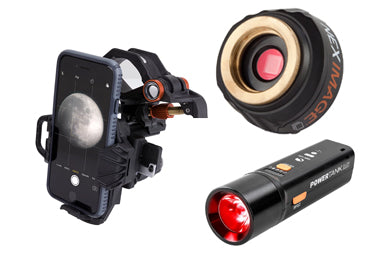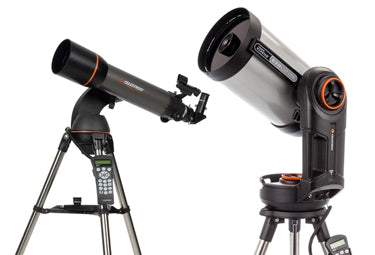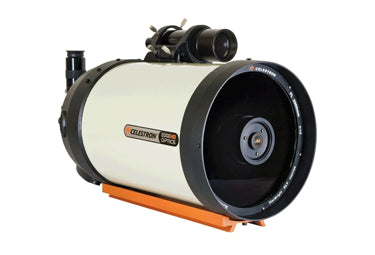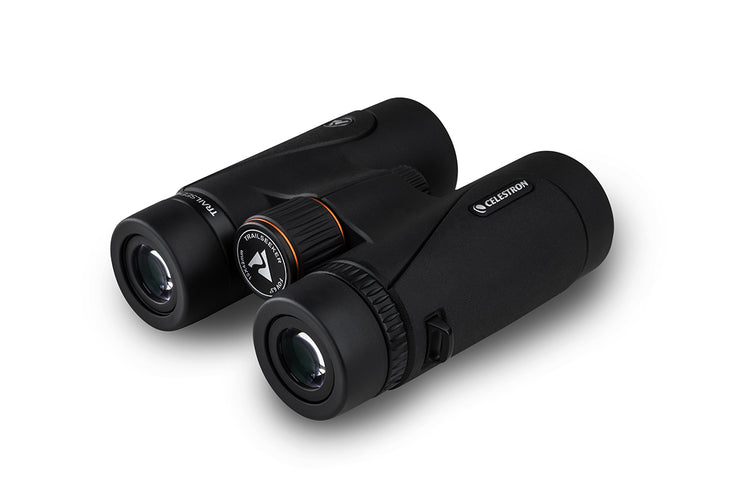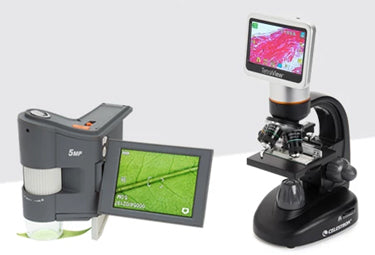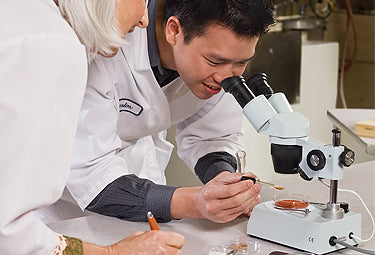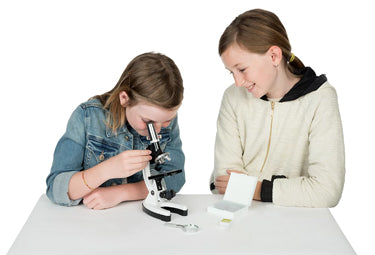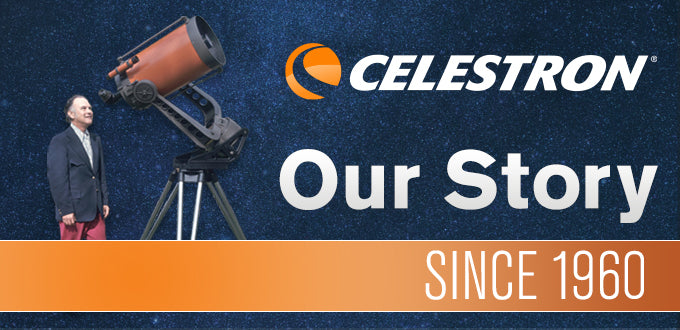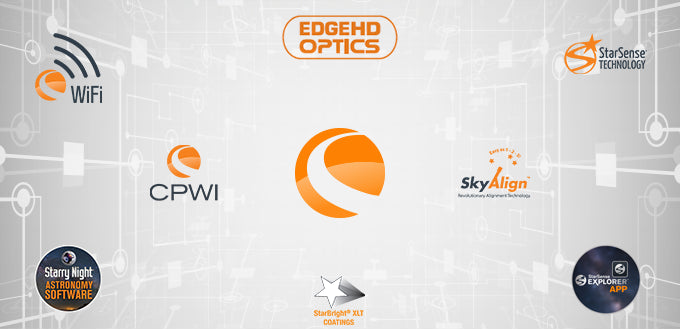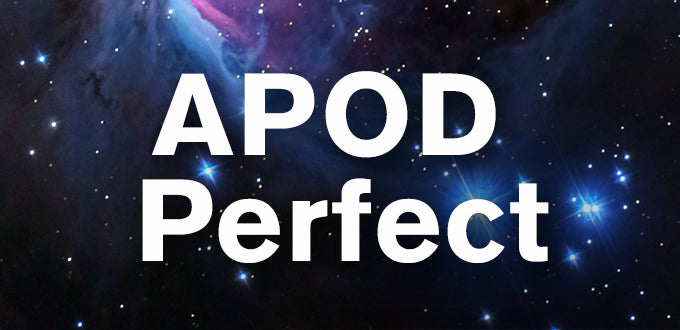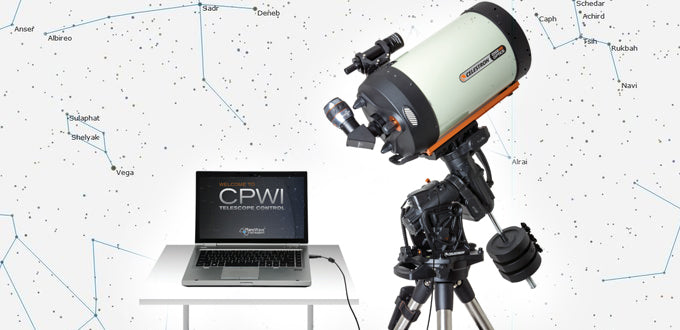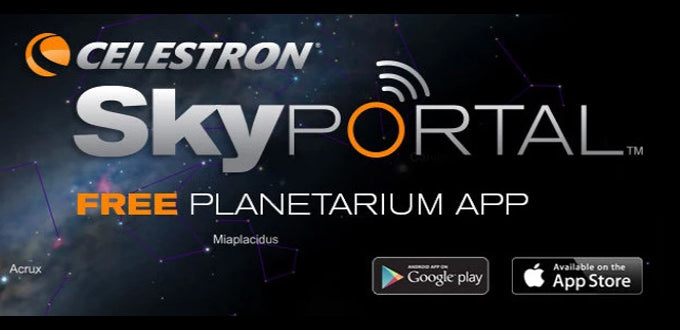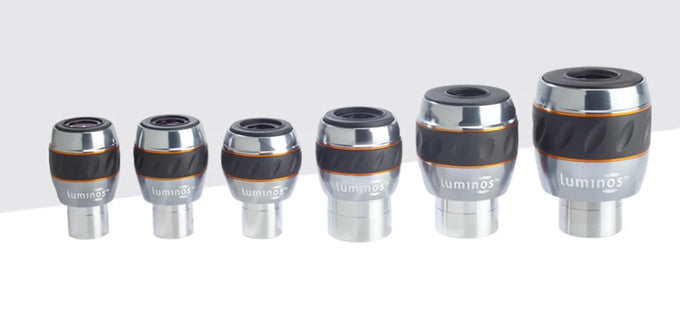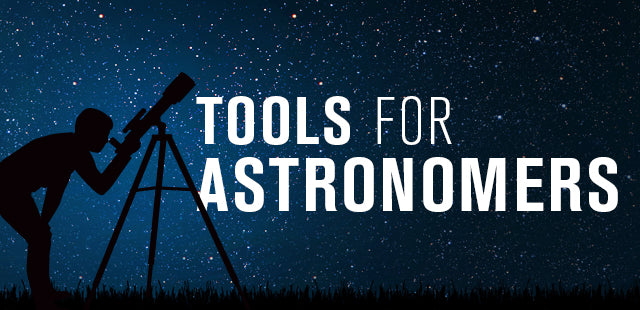From refractors to reflectors to Cassegrains—there are so many telescope optical designs to choose from, each with its unique advantages and disadvantages. In this guide, our experts break down each telescope type so you can make the best decision based on your wants and needs.
Refractor Newtonian Reflector Maksutov-Cassegrain Schmidt-Cassegrain EdgeHD Rowe-Ackermann Schmidt Astrograph

A Refractor is a long, thin telescope. Light passes through the refractor in a straight line from the front objective lens directly to the eyepiece at the opposite end of the tube. Typical focal ratio is f/5 to f/15.
Advantages:
|
Disadvantages:
|
- Refractors are the traditional optical design that the average person instantly visualizes when he or she hears the word "telescope"
- Easy to use and reliable due to the simplicity of design
- Little or no maintenance
- Excellent for lunar, planetary, and binary star observing especially in larger apertures
- Good for distant terrestrial viewing
- High contrast images with no secondary mirror obstruction
- Color correction is good in achromatic designs and excellent in apochromatic, fluorite, and ED designs
- Sealed optical tube reduces image degrading air currents and protects optics
- Objective lens is permanently mounted and aligned—fixed collimation
|
- More expensive per inch of aperture than Newtonians or catadioptrics
- Heavier, longer, and bulkier than Newtonians and catadioptrics of equivalent aperture
- Cost and bulk factors limit the practical useful maximum size objective to small apertures
- Less suited for viewing small and faint deep sky objects such as distant galaxies and nebulae because of practical aperture limitations
- Focal ratios for traditional refractors are usually long (f/11 or slower), making photography of deep sky objects more difficult (short focal length apochromats are now available that change this limitation, but their magnification is limited)
- Some color aberration in achromatic designs (doublet)
|

Newtonian Reflectors, including the Dobsonian (Dob), have a concave spherical or parabolic primary mirror at the back of the telescope that collects and focuses incoming light onto a flat secondary (diagonal) mirror. In turn, the secondary mirror reflects the image out of an opening at the side of the front end of the main tube and into the eyepiece. Typical focal ratio is f/4 to f/8.
Advantages:
|
Disadvantages:
|
- Because mirrors are less expensive to produce than lenses, Newtonian telescopes are usually less expensive for any given objective diameter (or aperture) than comparable refractor telescopes
- Reasonably compact and portable up to focal lengths of 1000mm.
- Short focal ratio (f/4 to f/8) offers a wider field of view
- The eyepiece is located at the top end of the telescope allowing for a much more compact mounting system, reducing cost and adding portability
- Low in optical chromatic aberrations
- Generally very little issue with dew except in very high humidity
- When used with a Dobsonian mount, reflectors are very simple to operate; targets can be found quickly by star hopping
- Reasonably good for lunar and planetary work, but larger apertures are better for deep sky objects
|
- When visual observing with large Dobs, the tube orientation can sometimes put the eyepiece in a poor viewing position, requiring a ladder to access it
- The location of a Newtonian’s secondary mirror and struts (the support structure for the mirror) creates a central obstruction and causes the appearance of diffraction spikes
- Newtonians with a focal ratio of f/6 or lower suffer from coma, an off-axis aberration that causes images to flare inward and towards the optical axis (stars take on a "comet-like" shape)
- Generally not suited for terrestrial observing due to visual images being inverted (upside down and backwards)
- Very bulky and heavy in 10" and larger sizes
- Fast Netwonians (f/6 and lower) need optics to be collimated regularly
- Additional coma corrector optics are needed for best performance for deep sky photography
- Planetary imaging may require very high power 3x-5x Barlows to obtain to suitable focal length for many cameras
- Dobs and other alt-az mounted Newtonians are more difficult to motorize and many may not track at all
- With larger Dobs, the base itself can be heavy and bulky
|
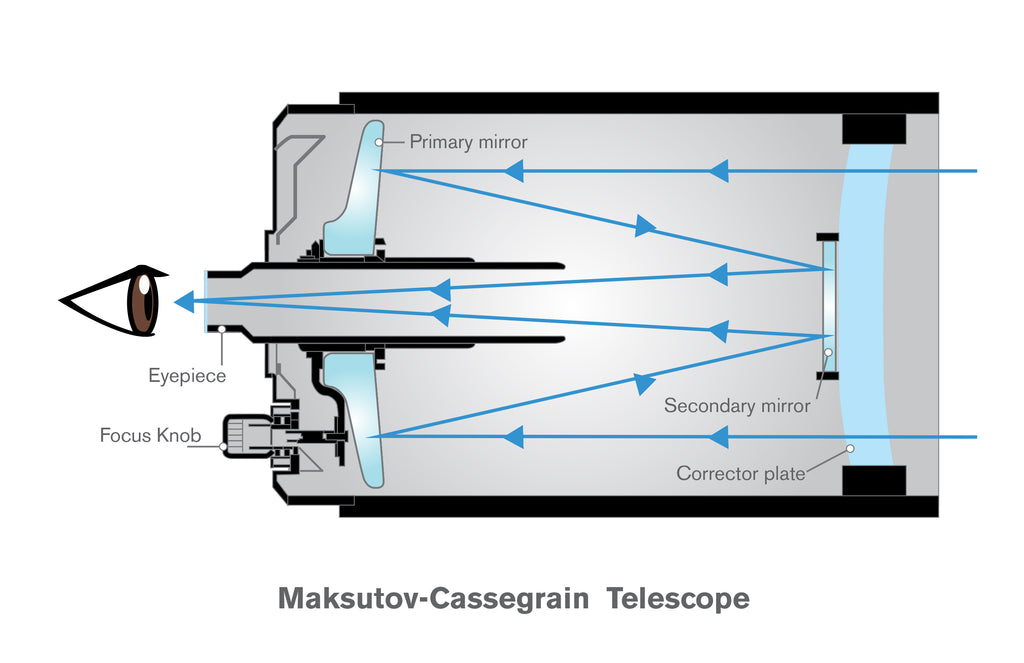
The Maksutov-Cassegrain (Mak) optical system uses a combination of mirrors and lenses and is referred to as a compound or catadioptric telescope. This unique design offers large-diameter optics while maintaining very short tube lengths, making them extremely portable. The Maksutov-Cassegrain system consists of a corrector lens, a spherical primary mirror, and a secondary mirror spot. Once light enters the optical system, it travels the length of the optical tube three times. Typical focal ratio is f/13 to f/15.
Advantages:
|
Disadvantages:
|
- Instead of a secondary mirror, most Maks features a “secondary spot” of reflective coating applied directly to the inside of the corrector plate, limiting the system's complexity
- Does not require frequent collimation as the optics are factory aligned
- Very compact for such a long focal ratio design
- Excellent for high-resolution lunar and planetary observation and photography, especially in larger sizes
- Moderate costs per inch of aperture compared to other optical designs
- Usually a smaller secondary obstruction compared to Newtonians and SCT-variants, meaning higher-contrast views than those designs
|
- The larger, heavier Maksutov corrector lens takes much longer to cool down and adjust to ambient air temperature
- Like SCTs, mirror flop can sometimes be an issue when reversing focus direction and during long imaging sequences
- There are generally no field flatteners or focal reducer/correctors optomized for Maksutovs, meaning that it can be difficult to correct for all aberrations with large camera sensors
- With such a slow focal ratio, very long exposures are needed for deep sky photography, and Fields of view are narrow, making it more difficult to image large and/or faint targets
- Dew can accumulate on the Maksutov corrector plate and may need to be managed with heaters or dew shields in humid locations
|

The Schmidt-Cassegrain (SCT) optical system uses a combination of mirrors and lenses and is referred to as a compound or catadioptric telescope. This unique design offers large-diameter optics while maintaining very short tube lengths, making themextremely portable. The Schmidt-Cassegrain system consists of a zero power corrector plate, a spherical primary mirror, and a secondary mirror. Typical focal ratio is f/10, f/2 if using Fastar capability.
Advantages:
|
Disadvantages:
|
- Best all-around, all-purpose telescope design—combines the optical advantages of both lenses and mirrors while mitigating their disadvantages
- Excellent optics with razor sharp images over a moderately-wide field
- Excellent for deep sky observing or astrophotography with film, DSLR, CCD or CMOS cameras
- Very good for lunar, planetary and binary star observing or photography due to long native focal lengths and high resolution
- Most are extremely compact and portable for their aperture
- Durable and virtually maintenance-free except for collimation, which is fairly simple and needs no special tools besides a high power eyepiece
- Large apertures at reasonable prices and less expensive than equivalent aperture refractors
- Most versatile type of telescope
- More accessories available than with other types of telescopes
- C5 optical tube has superior near-focus capability compared to other types of telescope (approximately 20 ft or 6 m)
- 6" to 14" optical tubes are Fastar compatible
|
- More expensive than Newtonians of equal aperture but far less exensive than refractors of similar size
- Due to secondary mirror obstruction, significant contrast compared to refractors
- Mirror flop can be an issue when changing direction with the focuser knob or during long imaging sequences
- Coma and field curvature present in optics are not usually noticeable in visual observing but show up in imaging with larger sensors
- Unlike large APO refractors or EdgeHD scopes, SCTs cannot correct a full-frame-size DSLR or CMOS sensors (43mm diagonal) and are better for APS-C (28mm diagonal) and smaller sensors
- Subject to dew accumulation on corrector plate, often requiring dew shields or heaters in more humid areas
- Larger sizes may need to have collimation checked after transporting the telescope by car to an observing site
|

EdgeHD is an advanced, flat-field, aplanatic optical design for visual observing and imaging with astronomical CCD cameras and full-frame digital SLR cameras. EdgeHD offers clean, diffraction-limited images for high power observation of the planets and the Moon. As an aplanatic, flat-field astrograph, EdgeHD’s optics provide tight, round star images all the way to the edges of a wide, 42mm diameter flat field of view for stunning color, monochrome, and narrow-band imaging of deep sky objects. Typical focal ratio is f/10 to f/11, f/2 if using Fastar capability.
Advantages:
|
Disadvantages:
|
- Same optical and observing strengths as the SCT design
- All models are Fastar-compatible
- All models have integraded Field Flattener lenses in the rear baffle tube that allow imaging with large DSLR, CCD, or CMOS sensors without requiring additional corrective optics
- Larger baffle tube diameter for 9.25", 11", and 14" models allows greater off-axis illumination
- Vents with 60-micron mesh added to the rear cell to speed cooling while blocking most dust particles and moisture from getting inside the optical tubes
- Optics are precision matched on each individual scope by Celestron for optimum imaging performance
- Optional dedicated 0.7x reducer for all sizes allows wider fields of view to be recorded with a digital camera and even be used with some 2" eyepiece/diagonal combinations on the larger models
- Focal reducers for 9.25", 11", and 14" maintain the full 146mm back focus, making it easy to switch the reducer in and out of image trains as desired
- All EdgeHD scopes cover a full-frame DSLR at native focal ratio, and all but the 8" will cover the same field with the 0.7x reducer as well
- Mirror tensioners have been added to fix focus and prevent mirror flop during a long exposure
|
- More expensive than SCTs for the same aperture as well as other designs besides APO refractors
- Has many of the same disadvantages of a conventional SCT except for Mirror tensioners and baffle tube diameter
- Back focus spacing needs to be precisely controlled for best optical and imaging performance, which may limit some more-complex imaging trains
- Subject to dew accumulation on corrector plate, often requiring dew shields or heaters to prevent this in more humid areas
- Larger sizes may need to have collimation checked after transporting the telescope by car to a different observing site
|

Rowe-Ackermann Schmidt Astrograph (RASA) is an incredibly fast (approximately f/2) optical system that delivers a flat field without optical aberrations. It cannot be used visually, but is capable of capturing stunning deep-sky astronomical images without the difficulties presented by slower and longer focal length telescopes. The astrograph can only be used with a camera. Focal ratio is f/2.2 or f/2.
Advantages:
|
Disadvantages:
|
- Modern astrophotography telescope with a cutting edge design and fabrication
- Optical design around f/2 that allows you to collect deep sky images using very short exposure times
- Flatter field with better off-axis illumination than an SCT or EdgeHD in Fastar configuration
- As of 2020, all sizes now have Ultra-Stable Focus System (USFS) that minimizes focus shift and mirror flop
- No fixed diffraction spikes like a fast Newtonian, and cables can be curved to reduce the visibility of any effects
|
- Cannot be used for visual observing
- Since the focal plane is at the front of the optical tube, large cameras or filter wheels can cause additional unwanted diffraction in images and reduce incoming light to the telescope by increasing obstruction
- Fixed back focus position with very little tolerance (< +/-0.5mm) for spacing errors
- For the RASA 8, very short 29mm back focus (25mm with included M42 T-adapter), which can limit options for using filters with some cameras
- Critical Focus Zone for RASA scopes is ~8-10 microns in depth, which can make accurate focusing more challenging, especially if the temperature shifts significantly during the night
- Greater care must be taken to ensure proper alignment and fastening of all imaging components compared to other telescope designs with slower focal ratios
- Many CMOS and CCD camera manufacturers do not correct tilt in their sensors to better than 20-50 microns corner-to-corner, so tilt can be visible in the corners of the frame with larger sensors and may require additional accessories to adjust tilt of the camera
- Placement of camera cables in front of the corrector plate can cause unwanted diffraction spikes and other artifacts if not managed carefully
- The same dew considerations as Maksutov, SCT and EdgeHD designs
- Taking Flats and Darks can be tricky due to the placement of the camera in front of the corrector
|



